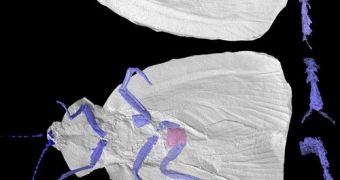British researchers from the Imperial College London (ICL) have recently developed the first three-dimensional representation of one of the earliest ancestors of the modern cockroach. The 3D “visual fossil model” features an exquisite level of detail, and is published in the April 13 issue of the esteemed scientific journal Biology Letters. The insect, that researchers believed was the original species from which the modern correspondents evolved over millions of years, is estimated to have lived no less than 300 million years ago, PhysOrg reports.
Most likely, experts believed, the creature crawled its way on land over the Carboniferous period, which spans between 359 and 299 million years ago, and it predates the appearance of dinosaurs by a considerable margin. It is widely believed that modern insect species including cockroaches, mantises and termites originated in the Archimylacris eggintoni ancestor. The new 3D model was based directly on a rare, fossilized specimen experts discovered some time ago.
Given that the early insect roamed the land just a few millions of years after lifeforms first stepped out of the ocean, and onto land, scientists are very interested in the adaptations to its environment A. eggintoni shows. The ancient bugs lived on the floor of primordial forests, and were usually between 2 and 9 centimeter (0.7 to 3.5 inches) in length, and about 4 centimeters, or 1.5 inches, in width. The work to model its structure was conducted by ICL Department of Earth Science and Engineering PhD student Russell Garwood.
“The Carboniferous period is sometimes referred to as the age of the cockroach because fossils of Archimylacris eggintoni and its relatives are amongst the most common insects from this time period. They are found all over the world. People joke about it being impossible to kill cockroaches and our 3D model almost brings this one back to life. Thanks to our 3D modeling process, we can see how Archimylacris eggintoni's limbs were well adapted for all terrains, as it was not only adept in the air but also very agile on the ground,” Garwood says of the ancestor species.
The model revealed that the creature had structures dubbed euplantulae on its feet, which were very likely used to confer the insect an improved level of grip on smooth surface. This would have come in very handy when A. eggintoni would have wanted to climb on leaves, the team believes. Additionally, small claws were discovered at the end of its feet, which means that the bug could most likely climb on tree bark, to take refuge, hunt for food, or deposit eggs, high above the ground, away from predators.

 14 DAY TRIAL //
14 DAY TRIAL //